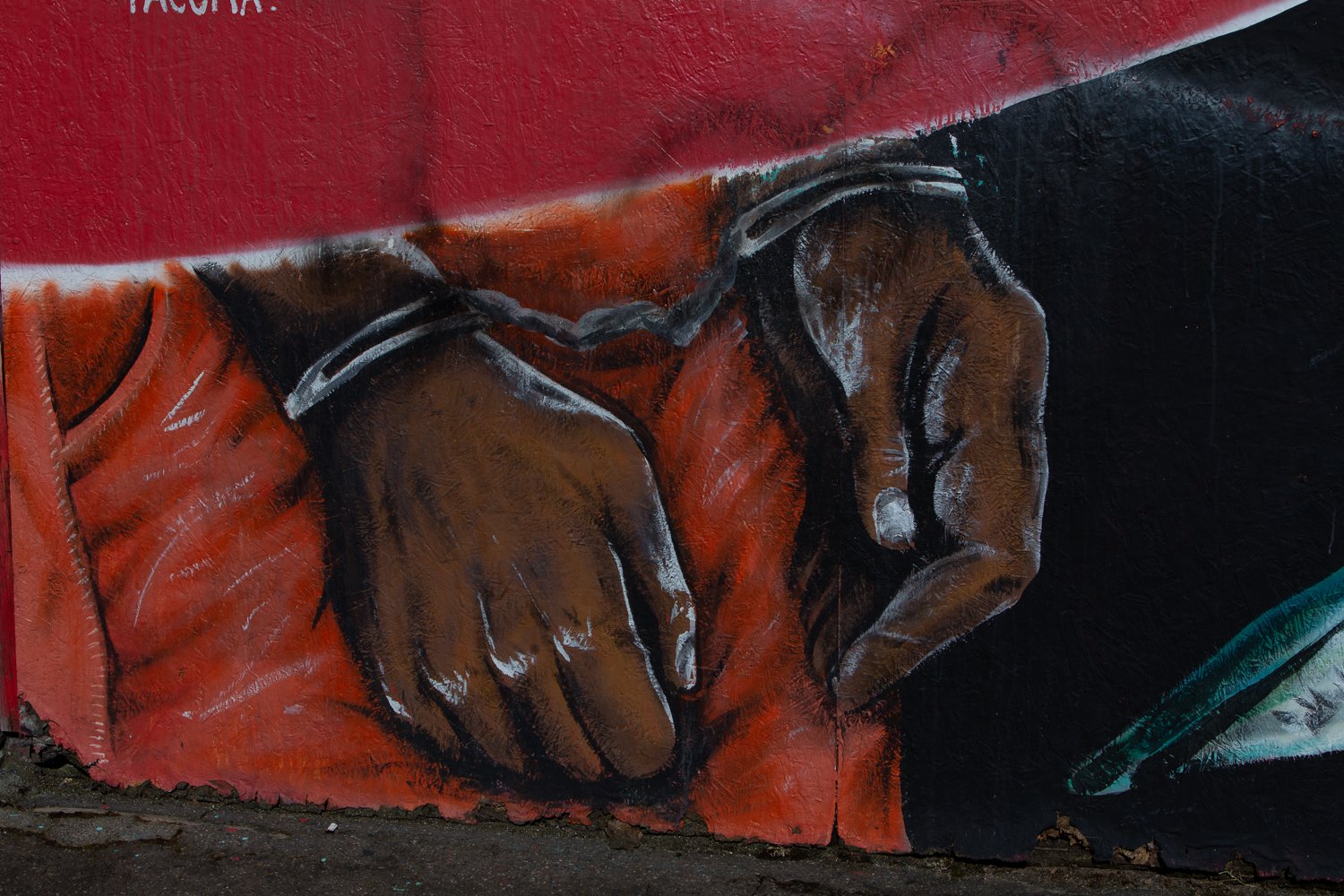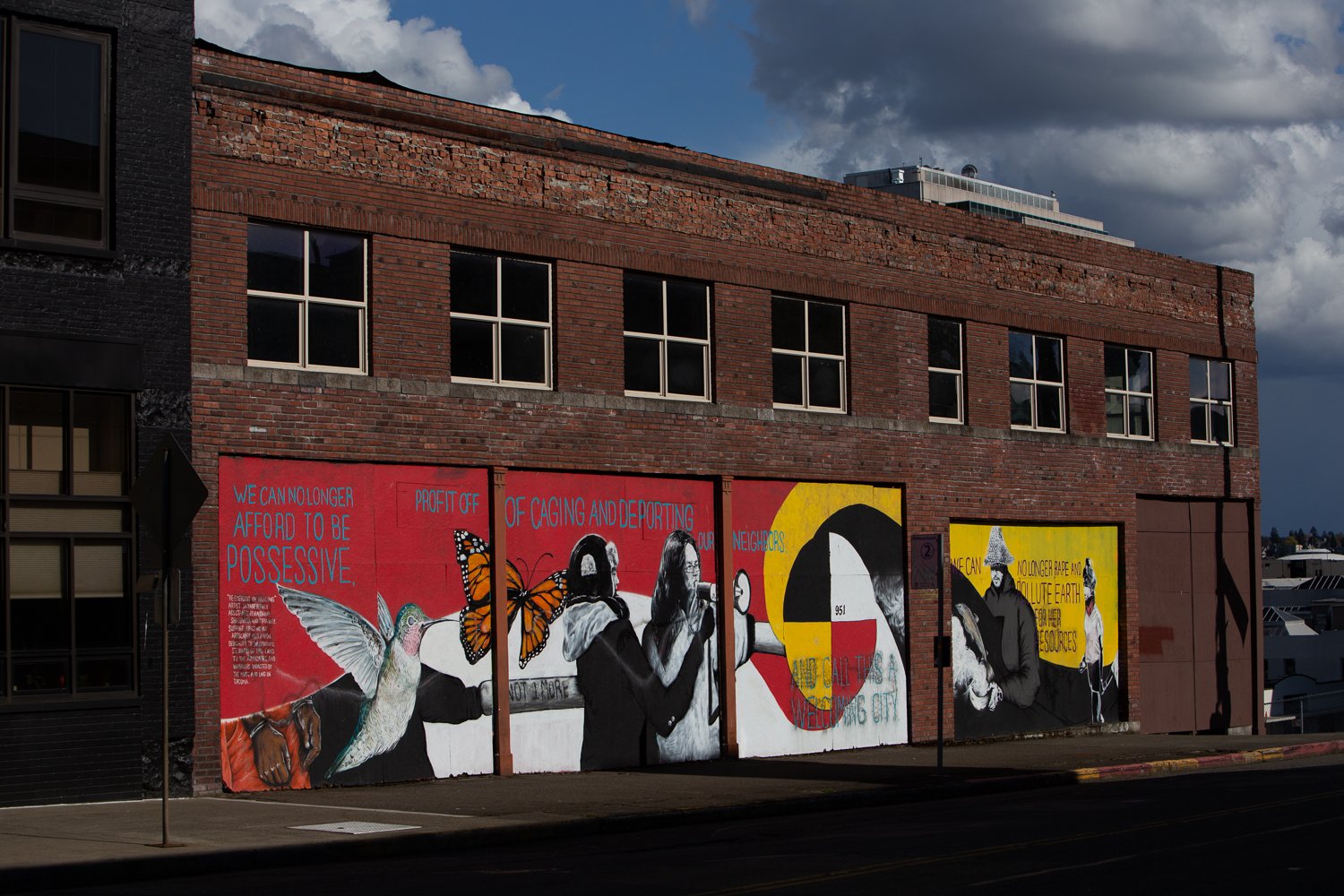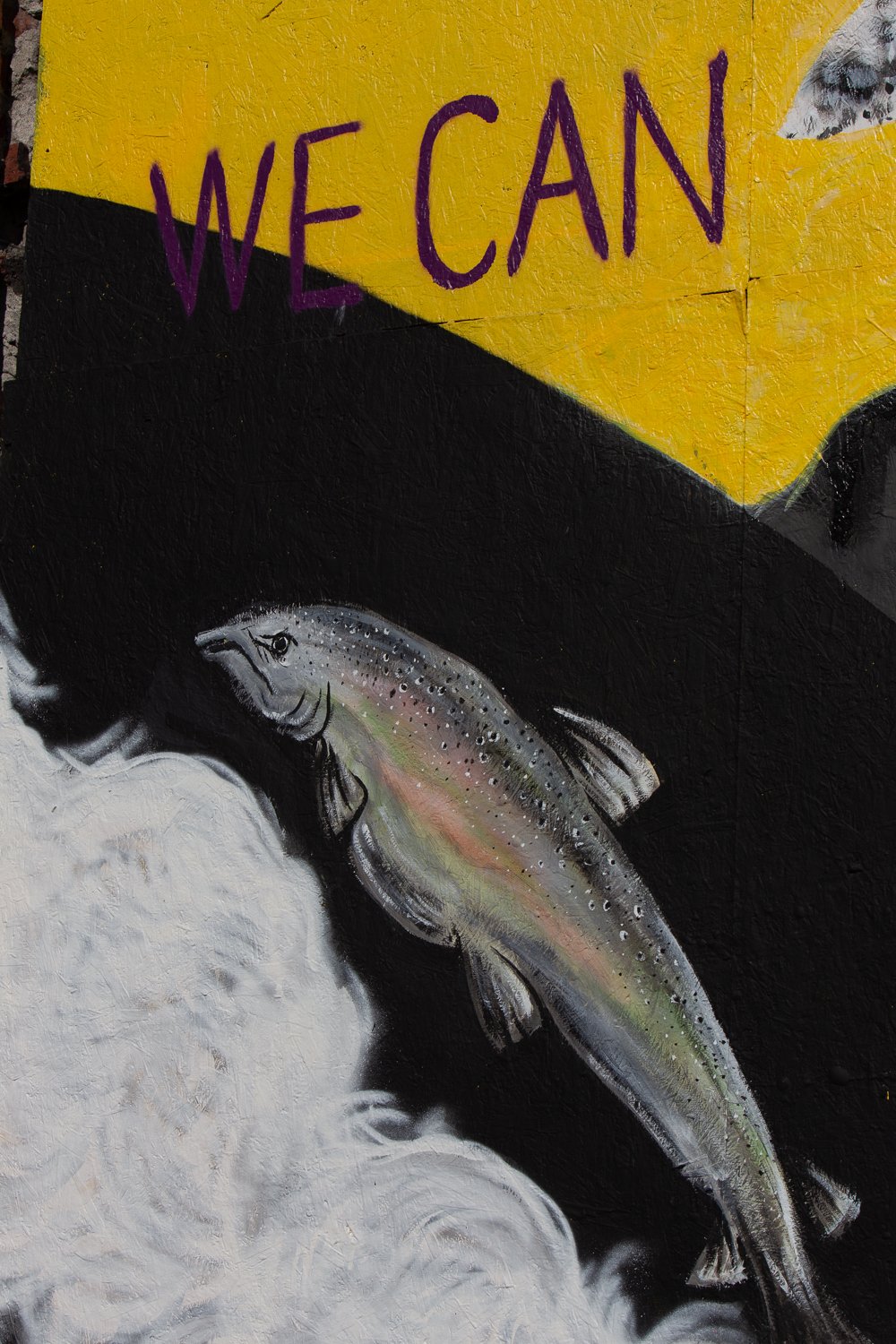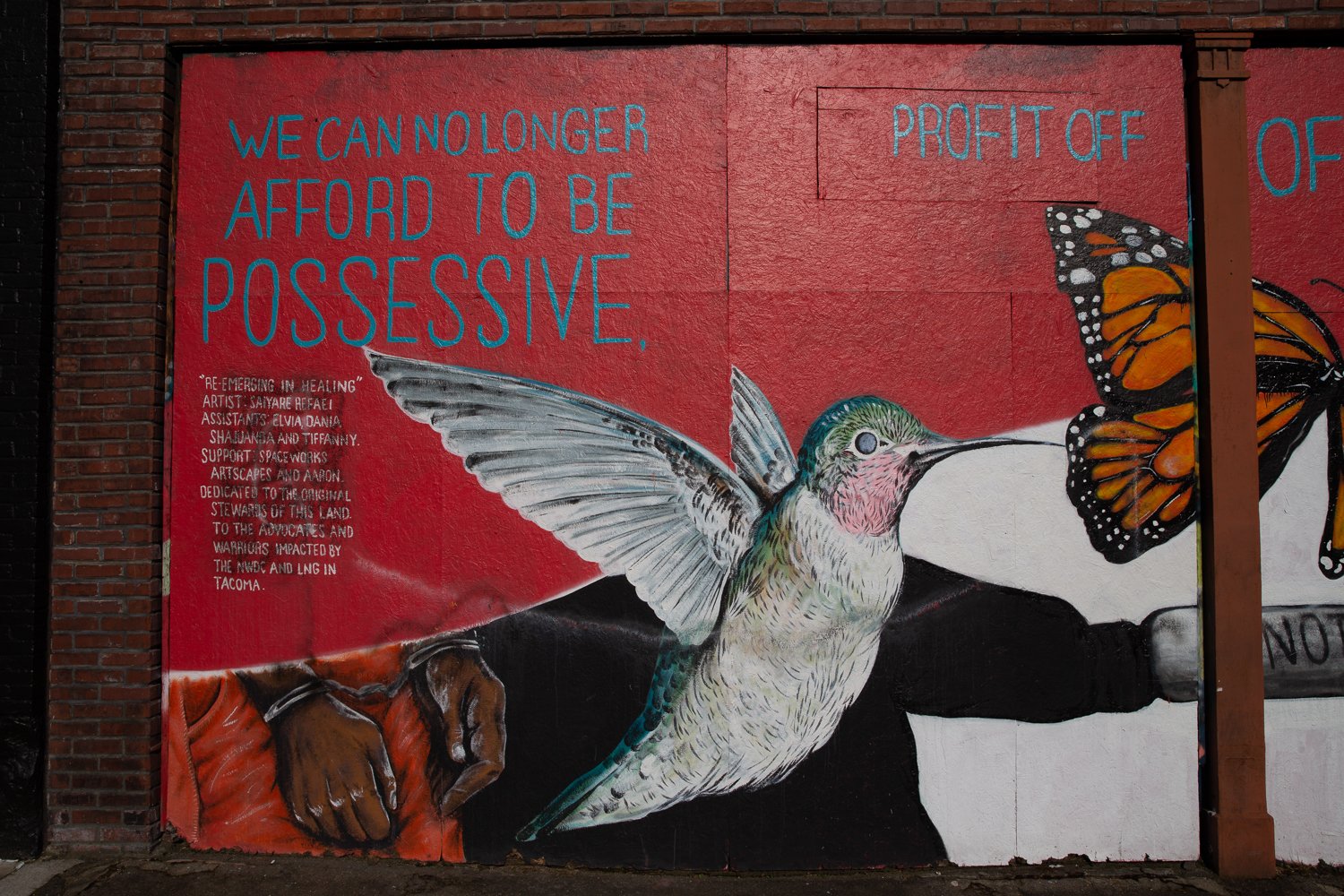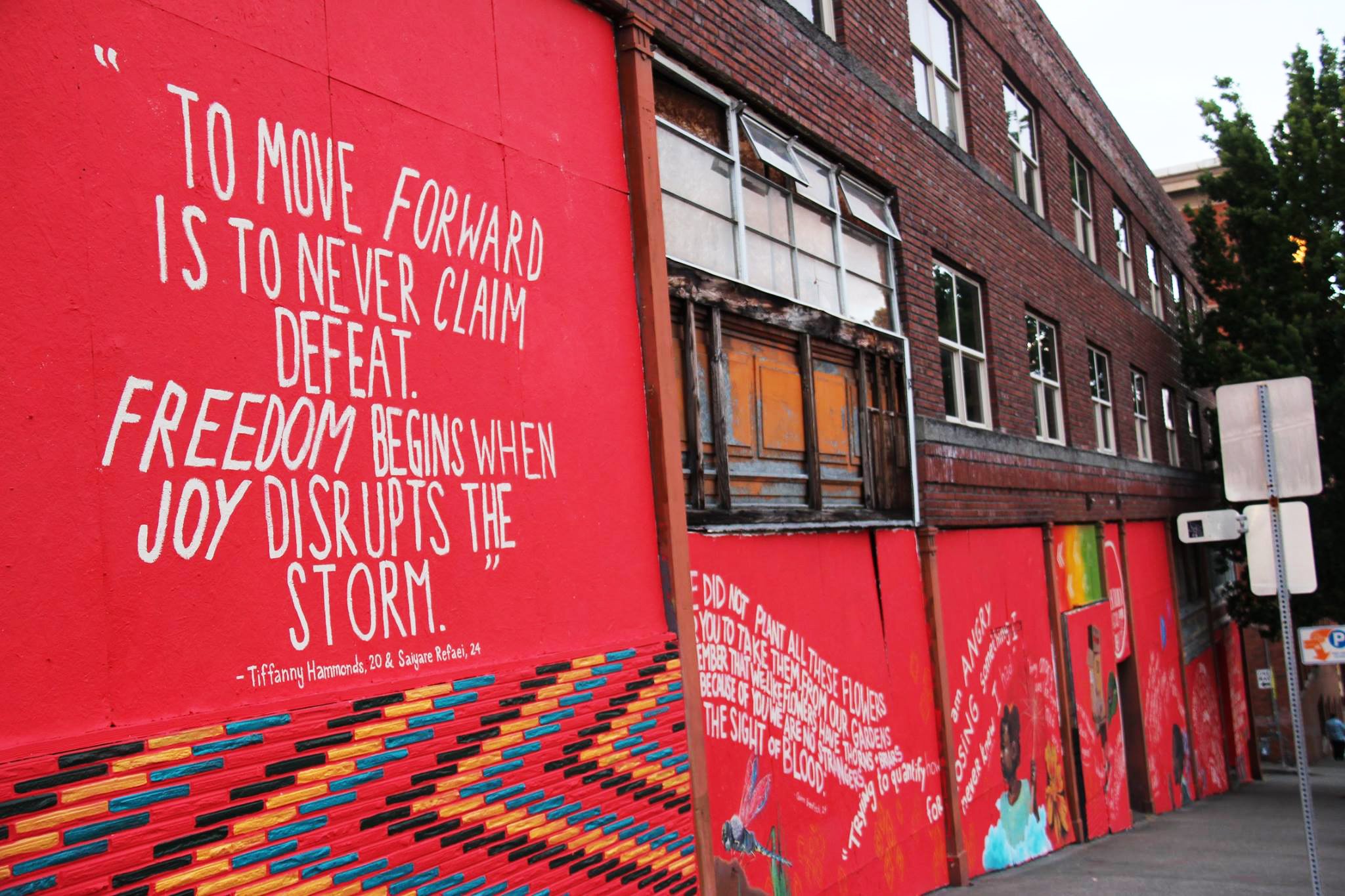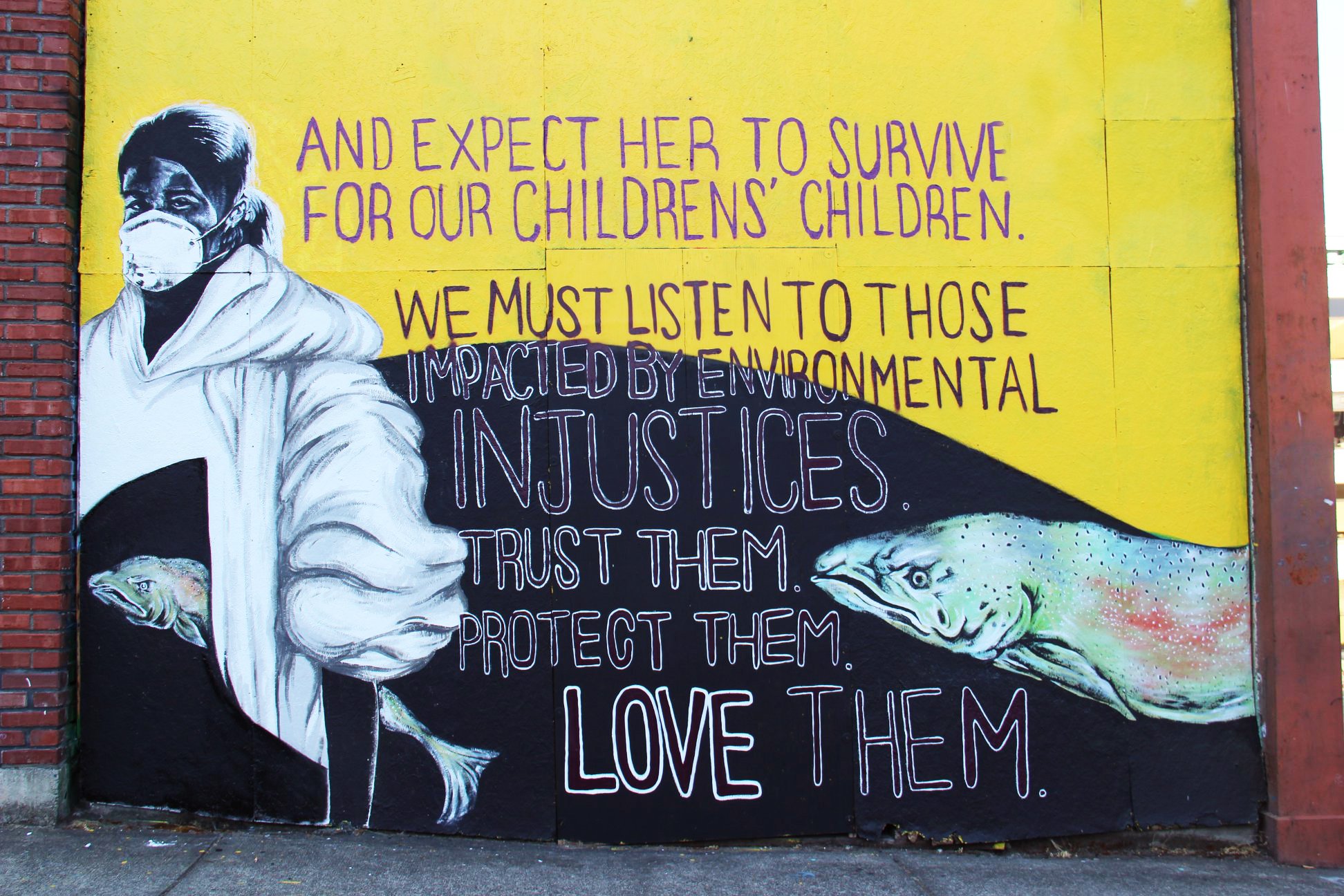Interview with Saiyare Refaei
Artist & Activist

Collateral:
Saiyare, thank you for sharing your time and art with Collateral. Could you tell us a little about who you are as an artist?
Saiyare:
From the point I could stand as a toddler, I would spend hours scribbling away on a fun-sized easel. My mom recalls a moment when she came over to me intently drawing. Her inquiry about what I was drawing was returned with a teenage-like stare that said, why are you bothering me, Mom?
I’m a very reserved and observant person. I like to include people in spaces and take note of what is missing. Creating art has been a way of trying to tell the stories I think need to be heard more in a community. What I may know as a pressing issue of a detention center or liquid gas facility in our backyard may not be as obvious to most of the nearby community. And every time I show up to community spaces and listen or witness what is happening to create art, capture photos, or share any words of reflection, art not only helps me process [those events] but strive to support local and international struggles. If painting a picture for someone to question a different way of being, to inform, to plant a seed for someone, then I see that creative endeavor as worth it.
Collateral:
In what medium do you create most often right now? What have you worked in before, and what would you like to try in the future?
Saiyare:
Reemerging Healing Mural by Saiyare Refaei
At the start of the pandemic, I was painting “rapid murals” to activate the boarded-up businesses in downtown Tacoma through Spaceworks and the Downtown Tacoma Partnership. Since then, I have tried a couple letterpress projects through Wayzgoose Tacoma. I tabled digitally drawn prints, postcards, greeting cards and stickers for the first-time last summer at a couple outdoor markets. I also collaborated on my first street mural on McKinley Avenue as part of the City of Tacoma’s storm drain campaign to better inform community about what goes down the drain making its way into the Puget Sound waterways. And last year I also became a published poet with three poems featured in We Need a Reckoning: Poetry, Essays, and Memoir by Women and Non-Binary People of Color.
During quarantine times I have been taking on more digital drawings. This medium of design has been a bit more socially distant and long-distance friendly way of collaborating to contribute to social movements with my fellow Justseeds Artist Cooperative artists (who reside all over the United States, Canada and Mexico). We continue to contribute to poster designs and graphics for national and international campaigns. Each year we also create a themed poster portfolio for subscribers of our Community Support Art (CSA) that helps raise funds for operational costs. Last year many artists contributed designs for a coloring book as well.
I might be forgetting something, but the last few years have been a lot of firsts. And I appreciate this opportunity to pause and recall what has happened. I hope to get to the point of having my own functioning printing space, maybe a personal website or store, and to work toward creating more functional art that aligns with more of my values. For example, last summer I tried growing and drying various flowers that can be utilized for making natural dyes. I would love to dive deeper into my own Persian and Chinese roots and make block prints using natural dyes instead of plastic-based inks. I used to draw meticulous pointillism portraits; I miss dedicating time to those as well.
Collateral:
Reemerging Healing Mural by Saiyare Refaei
Are there certain artists/pieces that have inspired your work or artistic process? (Also, the inverse of this question would be interesting: that you know of, is there a particular person or piece that has been influenced by your work as an artist?)
Saiyare:
I have been really inspired by so many of the artists in Justseeds. After I studied in Oaxaca, Mexico, for a semester in college, I learned about Justseeds Artists Cooperative. Seeing that there were many people creating radical art really shifted how I created and got me excited about making art again. It gave more of what I was creating purpose and meaning that it was lacking before. And I was better able to incorporate what I was learning in my courses and in community in the woodblock prints and screen-print images I was making.
(I don’t know of anyone creating something that was inspired or influenced by my work. But I do recall a former student I knew coming across the 5 Stages Mural that was a collaboration with Tiffanny Hammonds. She was so enamored by it that she told me she would often visit the wall to bring her some joy. And that meant a lot.)
Collateral:
How have your mural projects in Tacoma taken shape? How does the process begin?
Saiyare:
Reemerging Healing Mural by Saiyare Refaei
The first public mural project I worked on was the Parkland Community Mural Project my senior year of college. That was the first and most lengthy process, in part because I was learning with everyone as we went, and it turned into something much more intentionally centric to the Parkland community. Originally, the wall to be painted was inward facing to the Pacific Lutheran University campus. Then it was mentioned that PLU owned the Parkland Post Office building and that could be a more outwardly facing mural for community members to enjoy. This then turned into a longer yet more meaningful process of gathering community feedback and making design revisions based on their thoughts and opinions.
Since that one in 2013-2014, many of the subsequent murals have been temporary through the Spaceworks Artscapes program. There have been many collaborations that are fairly site specific, such as the back of the People’s Center in Tacoma to a wall on the inside of the library at Highline Community College. The mural on the back of the People’s Center, for example, was a collaboration of artists of color with the lead artist, Christopher Jordan. As we were witnessing the gentrification of the Hilltop Neighborhood developing, it was important to center the history of the People’s Center (previously called the Malcolm X Center) as well as the faces of many historically and presently pivotal Black people of Hilltop. The intentionality of what will reflect and resonate with the community had to be so present in those projects. That includes directly talking and working with community. For me, a pivotal starting point in most public projects includes asking the question, what is the story that needs to be told?
Collateral:
I’d like to know more about where you see immigrants, art, and artists in proximity to violent conflict. We’ve both worked with people detained in the Pacific Northwest; how do you see this area impacted (or not) by violent conflict? How has it changed or not changed?
5 Stages Mural
Saiyare:
Tacoma is home to the Northwest ICE Processing Center (NWIPC), previously and still commonly referred to as the Northwest Detention Center (NWDC). This facility was relocated from and easily tripled in size from its prior location in Seattle to the tide flats (a highly industrial zone) in Tacoma.
Initially, the facility was detaining and deporting undocumented people residing as far north as Alaska and as far east as Montana. These days, ICE is sending the majority of the current occupants up from the southern border as a strategy of intentionally separating people where they don’t have resources and community connections. Local advocates here have witnessed residents of the Tacoma area being transferred to detention facilities in Texas and Louisiana. The last couple of years, there have been instances when members of the Cambodian community detained in Tacoma were transferred to facilities on the east coast as well. There have also been instances when community members detained in NWDC became more public with their stories and were transferred to Texas as a way to divide them from the resources and connections they had built in Tacoma. And none of this accounts for the physical and psychological violence that occurs in the detention center, let alone the environmental hazards of being located in an industrial zone with poor air quality and potentially harmful water that causes people to break out in rashes and more.
When local artists speak out and share what’s going on or try to best reflect the immigrant communities, with the uptick in white supremacists organizing, these public art pieces are being targeted for defacement and vandalism which have been classified as hate crimes.
Collateral:
How do you interpret healing in the arts? In your own art? Where do you see the impact of healing for immigrants?
5 Stages Mural
Saiyare:
The process of art is healing because it’s a way to tap into our thoughts and feelings, and release some of what our body would otherwise be holding. For people being detained, there are no social programs, so one outlet for them includes making crafts to pass the time. The supplies have to be mailed to them under certain specifications, and some people make art from folding wrappers or paper, or crocheting hats; these items have been gifted to community groups such as La Resistencia, who can sell them to continue to support people detained. Creating helps people deal with boredom and sitting with so many of the compounded fears of being deported, not being able to support their loved ones, of catching Covid or another communicable disease, or even worsening existing chronic health issues that often go untreated when a person is detained.
And for those who don’t create art, for the immigrant community, it is so nice to see one’s culture reflected. In the United States we live in a society that upholds a dominant culture of valuing whiteness and assimilation. Reminders of one’s home country or a reflection of one’s culture is really cherished.
Collateral:
I’ve seen your work online, supported by your gratitude to the community around you. This made me think about the familiar assumption that art is a solo endeavor—that the arts are experienced as transactional between an individual and a group. What role does community (including its history) play in how you create?
Saiyare:
5 Stages Mural
Community is essential. Creating community ensures that they will be best reflected in the art and their history will not be forgotten. Often it is community seeking artists to tell their stories. For me, community members have been some of my greatest teachers and mentors, not only in the process of a project but in the way they emulate selflessness, compassion, and love for a place we all want to live and truly thrive in.
If I haven’t done my work to know the community who is going to experience a public piece of art about them, then I haven’t done my job as an artist.
Collateral:
I wondered if you could say more about the living nature of art. You have a temporary mural project up in Tacoma, and the word temporary makes me want to know what you think about art’s lasting impact and message, particularly when it is directly creating awareness about ongoing crises.
Saiyare:
The “Reemerging in Healing” mural is intended to be a temporary. It was painted back in 2018 to reflect and visit the possibilities of how the detention center and the LNG fights share commonalities and also could do a great service of healing the land if they come together. Because the ownership of that building has changed, the mural has stayed up longer than anticipated, as Spaceworks is building a better relationship with the owner. However, for pieces like this, I wish the issues at the core of them were not still relevant. I want what people may call “activist art” to remain a marker in time. People should not be detained. The community should not be at risk if something catastrophic happens to the LNG facility.
A piece of temporary art may still be a lasting memory of someone, and that is beautiful. And now with various online platforms, these pieces can live on in the digital realm too. But the digital space can never measure up to the experience of passing a wall that makes you stop for the first time. Because in a way it is these moments of finding what you needed to see, hear, or learn can be healing and educational for us.
Reemerging Healing Mural by Saiyare Refaei
Collateral:
What are you working on now?
Saiyare:
Coming up, a few Justseeds artists will be designing posters to support the Pargamanan-Bintang Maria forestline community and Rainforest Action Network (RAN)’s Keep Forests Standing Campaign. Justseeds will have more CSA posters printed this spring and I’m excited to collaborate with Andrea Narno on one of the CSA poster designs.
I’ll also be visiting Zygote Press in Cleveland, Ohio, this June 18th as a visiting artist. They are including me in their print and zine fair as well as having a printed hanky in the Queer Ecology Hanky Project show that is for sale. (For a portion of the day, I will be live printing a block too.) Normally 90 some queer identified artists are featured in this printed hanky show. If any of your readers are in the Cleveland area, they are more than welcome to stop by and support all the amazing artists that will be present!
There will be a couple other local projects, but you’ll have to stay tuned!
Collateral:
Where can readers learn more about your work?
Saiyare:
Readers can find more art, blog posts, and free graphics to download at Justseeds | Saiyare Refaei. They can learn more about NWDC through La Resistencia’s website La Resistencia (laresistencianw.org) and social media pages (for updates on what is happening inside the detention center) @laresistencianw. And they can learn about the LNG in Tacoma by watching Native Daily Network’s documentary Ancestral Waters.



